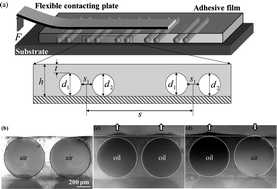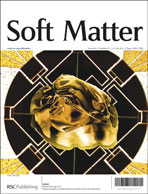Direction specific adhesion induced by subsurface liquid filled microchannels†
Abstract
While directional effects in adhesion and locomotion have in general been generated by creating symmetry breaking topographic features on the surface of a soft bodied object, here we present a novel method for imparting this effect to thin adhesive layers by embedding liquid filled microchannels arranged in pairs with specific intra and inter pair distances. The adhesive exhibits uniform adhesion in classical peel tests when both the channels are filled with either air or a wetting liquid. But the asymmetric effect shows up when only one of the channels in the pair is filled with the liquid. The liquid alters the surface tension of the inner wall of the channel, which results in bulging deformation of the thin skin of the adhesive over the channel. The bulging however remains asymmetric, the extent of asymmetry depending on the intra-pair spacing between the channels. Besides the bulging effect, filling in one channel of a pair with liquid also leads to an asymmetric variation in its modulus. As a result, when an adherent is peeled off the adhesive from two opposite directions, significantly different adhesion strengths result. A similar directional effect also results when channels of two different diameters are used in the pair, thus opening up the possibility of generating several different adhesion strengths simply by altering the geometric features of the embedded microstructure and its filling status. We show also that for both channels in a pair filled with liquid, the adhesion strength increases significantly, by over 60 times of what is achieved for a smooth, featureless, adhesive layer.


 Please wait while we load your content...
Please wait while we load your content...